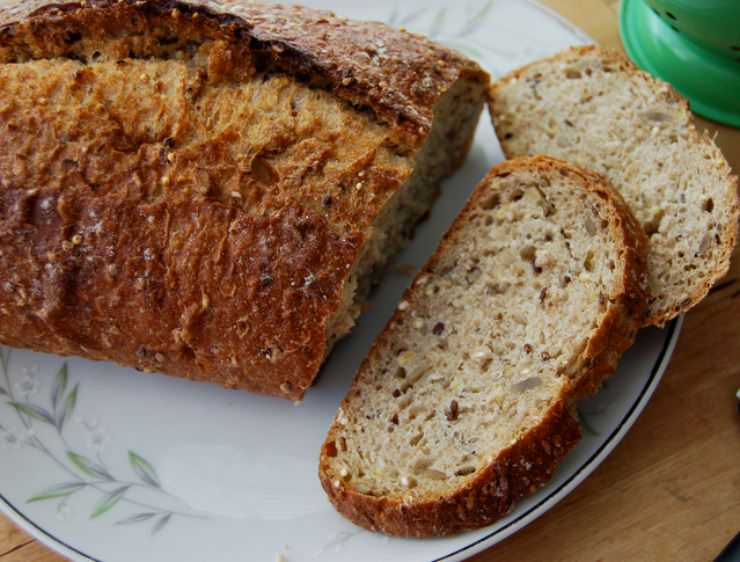 I realize the title of this post is rather shocking. I was floored too, when I first heard this information from Rami Nagel, author of Cure Tooth Decay, in a casual hallway conversation at a nutrition conference.
I realize the title of this post is rather shocking. I was floored too, when I first heard this information from Rami Nagel, author of Cure Tooth Decay, in a casual hallway conversation at a nutrition conference.
How could whole grains possibly cause cavities? I mean, whole grains are hard to digest, sure, but cavities?
Isn’t white bread, after all, one of the common causes of tooth decay because it is devoid of nutrition and basically white sugar dressed up as food? Isn’t white flour one of the “displacing foods of modern commerce” as written about by Dr. Weston A. Price in his groundbreaking work Nutrition and Physical Degeneration?
Dr. Price himself recommended consuming the entire grain (bran and germ) as have many health experts since his time. Scientific analysis of whole grains indicates a much higher level of minerals and overall nutrition than that of refined grains.
Based on scientific analysis alone, it seems clear that white bread should be avoided in the diet of those seeking nutrient dense foods and vibrant health. The health and condition of the teeth and mouth is a window to the body meaning that oral problems are the canary in the mine for problems brewing elsewhere. Note the strong link between periodontal disease and heart disease and stroke.
But, could there be something else going on here – something that a blind recommendation in favor of whole grains is missing?
Fact is, I know a number of folks that eat a whole foods diet including cod liver oil, never eat white bread and even go so far as to make their own whole wheat bread with fresh flour and they are still having cavity problems in the family.
Let’s dig beyond the sterile walls of a lab and see what else might be in play ….
Traditional Societies Did Not Typically Use the Whole Grain
The argument against whole grains stems from Rami’s claim that traditional societies did not usually make use of the entire grain. Rami has studied this issue in depth and has confirmed that the practice of removing the bran occurs traditionally in the French Alps with rye, in Africa with wheat and corn, and in Tibet with barley.
Why did these cultures remove the bran? Apparently, the practice occurs because the bran is loaded with plant toxins such as lectins that cannot easily be removed by sprouting, sour leavening, soaking or even cooking.
In the second edition of Cure Tooth Decay, Rami therefore recommends removal of the bran from wheat, spelt, rye, kamut, barley, corn, millet and oats through sifting or sieving.
Quinoa, buckwheat, and aramanth appear to be exceptions to this rule. Rice falls somewhere in between as traditional rice eating cultures typically removed some or all the rice bran before cooking. This was accomplished by pounding the rice into what is referred to as partially milled rice. I wrote about this in a past article which discusses why white rice is healthier than brown.
Once the Bran is Removed, What’s Next?
Rami goes further suggesting that whole grains must be soured first to significantly reduce phytic acid. Phytic acid is another big reason why grains cause cavities as this powerful anti-nutrient very effectively blocks mineral absorption in the gut. Phytic acid causes severe rickets when given to dogs as discovered and studied by researcher Edward Mellanby.
Rami’s research also indicates that sprouting grains does not reduce phytic acid significantly enough to make them safe for consumption.
In addition, Rami told me that soaking whole or sprouted grains in buttermilk, clabber, yogurt or kefir does not seem to reduce phytic acid content significantly. However, he did say that soaking will reduce phytic acid content but that plain, filtered water plus liquid whey is the best method for accomplishing this (substitute fresh lemon juice or apple cider vinegar for dairy free soaking).
What Are You Going To Do about Whole Grains?
I greatly respect Rami Nagel’s work and I think what he is discovering regarding tooth decay and healing tooth and gum problems in general is truly ground breaking. Therefore, I plan to adjust the preparation of grains in my own home based on our conversation that is summarized in this post. Here’s what I plan to do:
- Since I usually prepare my freshly ground grains by soaking in yogurt or kefir, I will immediately modify this approach to soaking in filtered water plus liquid whey instead. The rule of thumb for soaking is one cup of filtered water plus 1 TBL liquid whey per cup of flour mixed well together, covered and left overnight on the counter.
- I will begin sifting my flour to remove most of the bran before soaking.
- I will be sifting and then soaking my sprouted flour before baking since sprouting alone does not seem to reduce phytic acid content significantly.
- I had already switched years ago to white basmati rice from brown rice so no change needs to be made there.
What changes to your grain preparation techniques will you implement based on this information, if any? Please share your ideas.








Hi Diana, when you sift your fresh flour, much of the bran stays in the sifter. This is what you discard. Some of the bran will still go through, yes, but that is ok from what I understand from Rami. Getting most of the bran out is the goal not every single bit.
Hi Elizabeth, I totally agree with you .. the societies that did eat the whole grain (such as the Swiss and their sourdough bread) had such high amounts of Activator X (vitamin K2) in their diet that it probably offset the mineral blockage by the high phytate bran portion of the grain even though the grain was sour leavened. This is just an hunch though.
Hi Kelly, yes some do fine without grains, but I tend to not recommend this as it is cost prohibitive for most people to eat this way. Grains are a cheap filler food and if Rami's way of preparing them makes them digestible enough so folks can eat them and not suffer health consequences as traditional peoples did, then this is the best way to go for the vast majority of folks. We ate GAPS which is basically paleo in my household of 5 for almost 6 months and it almost doubled the food budget. This is just too much for most families to handle long term. Learning how to prepare grains the right way is absolutely the way to go for the vast majority of people.
**”Grains are a cheap filler food”**, You say it yourself, what you don’t say is that grains are also caloricly dense nutritionally poor filler food. They are the paupers food and only subtract from the diet.
But I wouldn’t say that foods high in calories and low in micronutrients is bad for you.
Oh it did post! Sorry about that! Thank you for your post Sarah!
I made a long comment, but it was too long! SO in short, Make sure you have an ABUNDANCE of fat soluble vitamins and minerals in your diet, so that some grains won't be that big of a deal, because your body has such an abundance – it won't need to steal from your bones!
Eat more Raw Pastured Spring Butter!
Sarah,
I've read Rami's 1st edition from cover to cover- and I have his new edition waiting to be read. I too was at the conference, and went to Rami's presentation.
This topic is of abundant importance to me- as through my childhood-teen years had 16 amalgam fillings placed- and had even more cavities than that. It's not something to be ashamaed of- but it's something a lot of kids have to go through. I'm on the pathway to preventing my daughter from ever having that issue- and I am healing my own body and teeth. I've seen great improvements in the last 2 years, a decreased sensitivity, and really no more tooth aches- it all started with taking FCLO and raw milk- but it does take more than that.
I think, that a majority of people are very malnourished- and that leads to tooth decay in a large percentage of those people.
It seems that a theme from the conference was- if you are sick, or not in perfect health, have any symptoms- or suffer from any degree of tooth decay- it would be of benefit to "TRY" avoiding grains- at least for a period of time until your body can heal and better absorb and break down the grains.
Personally, I'm a "wheat is the staff of life" kind of girl, so it's really challenging to avoid grains completely- but reducing the amount, and getting a non GMO grain, and properly preparing it- seems like a good compromise.
Dr. Weston A Price had 100% reversal of cavities in his group of school children- just by feeding them One solid meal- and that meal included "a roll made with freshly ground wheat flour" but it's important to note that that roll was SMOTHERED in high vitamin X factor butter-
Maybe part of the issue is making sure we have an ABUNDANCE of fat soluble activators to make sure those grains we do eat are usable and that we have so much mineral and fat soluble concentration in our foods that it won't be a big deal if we eat some grains.
It’s important to remember that when Price spoke of “displacing foods of modern commerce” he didn’t just mean the foods of modern commerce were bad for you, but that they were especially bad when they *displaced* what one’s body needed.
Had the indigenous groups he studied with all the dental problems simply added on a few industrial foods to their traditional diets, they might have still had the occasional problems, but they wouldn’t have been devastated to the degree that he recorded.
My family is Cajun and if you looked at my grandparents’ generation you’d see some chronic disease (I was born in ’74) but on the whole you’d see well-formed bodies and pretty fair disease resistance. But in my parents’ generation and mine you see the industrial foods *replacing* the traditional foods rather than accompanying them, with the expected adverse results. My parents are both type 2 diabetic now and my face is underdeveloped with a narrow maxilla and not enough room for all my teeth. You can see in my mother’s bone structure where she’d had at least some good nutrition prenatally and while she was growing up, but I got the short end of the stick.
Diana, I agree it's an interesting topic. Usually you just hear about whole grains vs. industrial refined grains. It's intriguing to learn about exactly how traditional cultures prepared their grains. From what I've read, there isn't an across-the-board method, though I believe grinding the grain fresh and fermentation were widely used. I honestly think fresh grinding is very important, though I imagine the traditional way of doing so allowed for the bran to be sifted out. I can see how that would be difficult with a typical modern grain mill.
Sorry, from my last post I meant we stopped eating brown rice and switched to white basmati rice that we eat 1-2 times a week.
Also, I simply love your blog Sarah, I even added the link to my Blogroll!
🙂
I have also read Rami's book, and also asked him a few questions over email about my daughter's severe cavities 2 years ago (she is 7 now). In his book he recommended to avoid whole grains, even properly prepared for people who are trying to cure cavities. So I am doing it, and my daughter's teeth are improving. Also since she started on raw milk her adult teeth came in looking really healthy. The only things we do not avoid are buckwheat, since this is not technically a grain but from a rhubarb family I think (it is also a traditional food in Russia where we are from), and sometimes I make pumpkin millet porridge that she loves. We also switched to white basmati rice instead of continuing to eat white rice, and I soak rolled oatmeal that we might eat once a week in whey as you Sarah recommended.
I'm with Morgan – go paleo! We don't eat grains or sugar (only local, raw honey) and we don't do A1 milk.
Tina